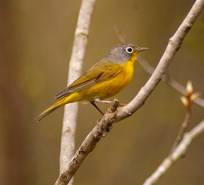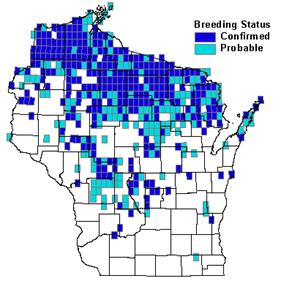Photo by Dennis Malueg


Status/Protection
- Global Rank: G5 Key to global and state ranks
- State Rank: S4B
- WBCI Priority: PIF, State Threatened
Population Information
Federal BBS information can be obtained at http://www.mbr-pwrc.usgs.gov/bbs/bbs.html by clicking on Trend Estimates and selecting the species in question. All estimates are for 1966-2005.
*Note: There are important deficiencies with these data. These results may be compromised by small sample size, low relative abundance on survey route, imprecise trends, and/or missing data. Caution should be used when evaluating this trend.
- Federal Breeding Bird Survey: non-significant increase
- Federal Breeding Bird Survey (WI): non-significant increase
- Federal Breeding Bird Survey (BCR 23): non-significant decline
- Federal Breeding Bird Survey (BCR 12): non-significant increase
- Chequamegon National Forest Bird Survey (NRRI): non-significant increase (1992-2005)
- WSO Checklist Project: increase (1983-2007)
Life History
- Breeding Range: Saskatchewan east across southern Canada to the Atlantic Coast south into the Great Lakes and New England states (Williams 1996).
- Breeding Habitat: Black Spruce, Swamp Conifer-Balsam Fir, Tamarack, Fir-Spruce, Jack Pine, Red Pine, White Pine, White Cedar, Alder Thicket, Aspen, Forested Ridge and Swale, Open Bog-Muskeg.
- Nest: Cup, on or near ground hidden by leaves, grasses, mosses, or low bushes (Williams 1996).
- Nesting Dates: Eggs: late May to early June (Robbins 1991).
- Foraging: Foliage glean, ground glean, hover and glean (Ehrlich et al. 1988).
- Migrant Status: Neotropical migrant.
- Habitat use during Migration: Trees, shrubs in the mid-canopy; woodland edges (Williams 1996).
- Arrival Dates: Late April to late May (Robbins 1991).
- Departure Dates: Mid-August to mid-October (Robbins 1991).
- Winter Range: Extreme s. Texas, Mexico, Guatemala, and Belize (DeGraaf and Rappole 1995).
- Winter Habitat: Primary and second-growth tropical deciduous forests, cloud forest (Williams 1996).
Habitat Selection
Throughout its range, the Nashville Warbler prefers second growth, open deciduous or mixed-species forests (Williams 1996). In Wisconsin it occurs in these and a variety of other habitat types, including boreal forest stands (Mossman et al. 1990), jack pine forests (Hoffman and Mossman 1990, Robbins et al. 1996), wetland conifer forests, and pine barrens (Mossman and Epstein 1991) but is relatively uncommon in northern mesic forests (Hoffman 1989). In the Chequamegon-Nicolet National Forest, it prefers saw-sized jack pine, pole-sized jack pine and tamarack, regenerating jack pine and red pine, and alder (Danz et al. 2007). Within these habitats, a well-developed ground cover (Howe 2006) and a conifer component (Pearson and Niemi 2000) are important characteristics. Nests are built on or near the ground, concealed by leaves, grasses, or mosses, and often located along forest edges and other clearings (Williams 1996).
Habitat Availability
Habitat is likely not limiting the Nashville Warbler in Wisconsin, which appears to be less vulnerable to habitat change than many other Neotropical migrants. It readily uses second-growth and cut-over areas (Williams 1996), which are prevalent in the logged northern region of the state. Furthermore, it is able to use a variety of forest types, many of which remain common on the landscape. Exceptions include white pine and boreal forest communities which have experienced significant loss within the past century (Mossman et al. 1990, WDNR 2005) and jack pine forests which currently face considerable threats. Jack pine forests continue to be replaced by red pine plantations in many areas of Wisconsin and face possible extirpation in less than 200 years according to some climate change models (Scheller and Mladenoff 2005).
Population Concerns
Breeding Bird Survey data suggest an annual increase in Wisconsin and range-wide, although neither are statistically significant trends (Sauer et al. 2005). Robbins (1991) considered the Nashville Warbler a common summer resident in northern Wisconsin and uncommon in the central region. Wisconsin Breeding Bird Atlas observers also documented higher concentrations in northern Wisconsin and confirmed breeding in 25% of the surveyed quads (Howe 2006). The Nashville Warbler’s ability to utilize second-growth forests and other edge habitats seems to ensure its continued stability in the state. However, its stability on the wintering grounds is not as certain and requires more study.
Recommended Management
The protection of lowland coniferous forests and muskegs should be a priority. Forest management practices that promote natural regeneration of jack pine and restoration/maintenance of hemlock, balsam fir, and other conifer species within northern forest ecosystems will benefit this species. This species will respond favorably to timber harvest provided a well-developed shrub layer is present (Schulte and Niemi 1998), thus maintaining structurally complex understories should be a priority. Conservation and management strategies for this species should be focused in the following Wisconsin ecological landscapes: Central Sand Plains, Forest Transition, Northeast Sands, North Central Forest, Northwest Sands, Northwest Lowlands, Superior Coastal Plain, and Northern Highland. On the wintering grounds, protection of tropical deciduous forests and cloud forest is important for this and a wide-range of other Neotropical migrants (Williams 1996).
Research Needs
More research is needed on the breeding biology of the Nashville Warbler. Studies that measure reproductive success within different forest types and forest management regimes would further conservation efforts for this species. The impacts of Brown-headed Cowbird parasitism on Wisconsin population of Nashville Warblers needs more study. This species adapts well to habitat changes within its North American range, but the impacts of habitat alteration on the wintering grounds needs more study (Williams 1996).
Information Sources
- Chequamegon National Forest Bird Survey (NRRI) species account: http://www.nrri.umn.edu/mnbirds/accounts/NAWAa2.htm
- Cornell Lab of Ornithology species account: http://www.birds.cornell.edu/AllAboutBirds/BirdGuide/Nashville_Warbler.html
- Great Lakes Bird Conservation probability map:
- http://www.uwgb.edu/birds/greatlakes/species/nawamap2.htm
- Nicolet National Forest Bird survey map: http://www.uwgb.edu/birds/nnf/species/NAWA.htm
- North American Breeding Bird Survey: http://www.npwrc.usgs.gov
- Temple S.A., J.R. Cary, and R. Rolley. 1997. Wisconsin Birds: A Seasonal and Geographical Guide. Wisconsin Society of Ornithology and Wisconsin Department of Natural Resources, Madison, WI.
- Wisconsin Breeding Bird Atlas: http://www.uwgb.edu/birds/wbba/
References
- Danz, N.P., G.J. Niemi, J. Lind, and J.M. Hanowski. 2007. Birds of Western Great Lakes Forests. www.nrri.umn.edu/mnbirds (10 April 2007)
- DeGraaf, R.M. and J.H. Rappole. 1995. Neotropical migratory birds: natural history, distribution, and population change. Comstock Publ. Assoc., Cornell Univ. Press, Ithaca, NY.
- Ehrlich, P.R., D.S. Dobkin, and D. Wheye. 1988. The birders handbook: a field guide to the natural history of North American birds. Simon & Schuster, Inc. New York.
- Hoffman. R.M. 1989. Birds of Wisconsin northern mesic forests. Pass. Pigeon 51(1): 97-110.
- Hoffman, R.M. and M.J. Mossman. 1990. Birds of northern Wisconsin pine forests. Pass. Pigeon 52(4): 339-356.
- Howe, R.W. 2006. Nashville Warbler. In The Wisconsin Breeding Bird Atlas (N.J. Cutright, B.R Harriman, R.W Howe, eds.). The University of Wisconsin Press: Madison, WI.
- Howe, R.W., M.J. Mossman, and S.A. Temple. 1992. Effects of natural forest management on birds in northern Wisconsin. Pass. Pigeon 54 (4) 297-306.
- Mossman, M.J., E. Epstein, and R.M. Hoffman. 1990. Birds of Wisconsin boreal forests. Pass. Pigeon 52(2): 153-168.
- Mossman. M.J. and E. Epstein. 1991. Birds of Wisconsin pine and oak barrens. Pass. Pigeon 53(2): 137-163.
- Pearson, C.W. and G.J. Niemi. 2000. Effects of within-stand habitat and landscape patterns on avian distribution and abundance in northern Minnesota. Pp. 81 - 95 In S.G. Conrad (Ed.) Disturbance in boreal forest ecosystems: human impacts and natural processes. USDA Forest Service, North Central Research Station, GTR NC-209.
- Robbins, S. D. 1991. Wisconsin birdlife: population & distribution, past & present. Univ. of Wisconsin Press, Madison, WI.
- Robbins. S.D., D.W. Sample, P.W. Rasmussen, and M.J. Mossman. 1996. The breeding bird survey in Wisconsin: 1966-1991. Pass. Pigeon 58(2): 81-180.
- Sauer, J.R., J.E. Hines, and J. Fallon. 2005. The North American Breeding Bird Survey, Results and Analysis 1966 - 2005. Version 6.2.2006. USGS Patuxent Wildlife Research Center, Laurel, MD.
- Scheller, R.M. and D.J. Mladenoff. 2005. A spatially interactive simulation of climate change, harvesting, wind, and tree species migration and projected changes to forest composition and biomass in northern Wisconsin, USA. Global Change Biology 11: 307–321.
- Schulte, L.A. and G.J. Niemi. 1998. Bird communities of early-successional burned and logged forest. Journal of Wildlife Management 62(4): 1418-1429.
- Williams, J. 1996. Nashville Warbler (Vermivora ruficapilla). In The Birds of North America, No. 205. (A. Poole and F. Gill, eds.). The Academy of Natural Sciences, Philadelphia, PA, and the American Ornithologists’ Union, Washington, D.C.
Contact Information
- Compiler: William P. Mueller, iltlawas@earthlink.net
- Editor: Kim Kreitinger, K.Kreitinger@gmail.com | Jon Robaidek, Jon.Robaidek@Wisconsin.gov
